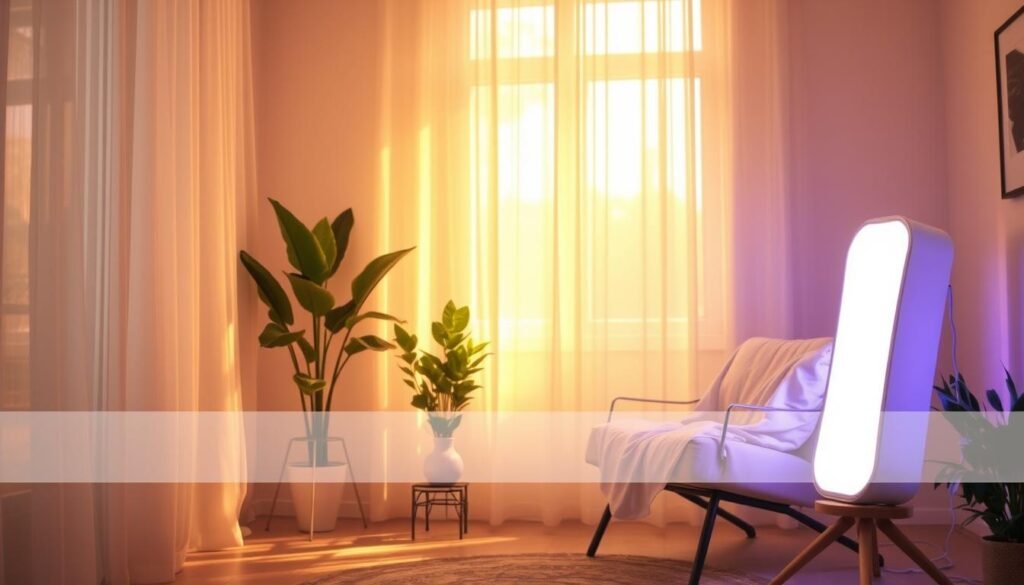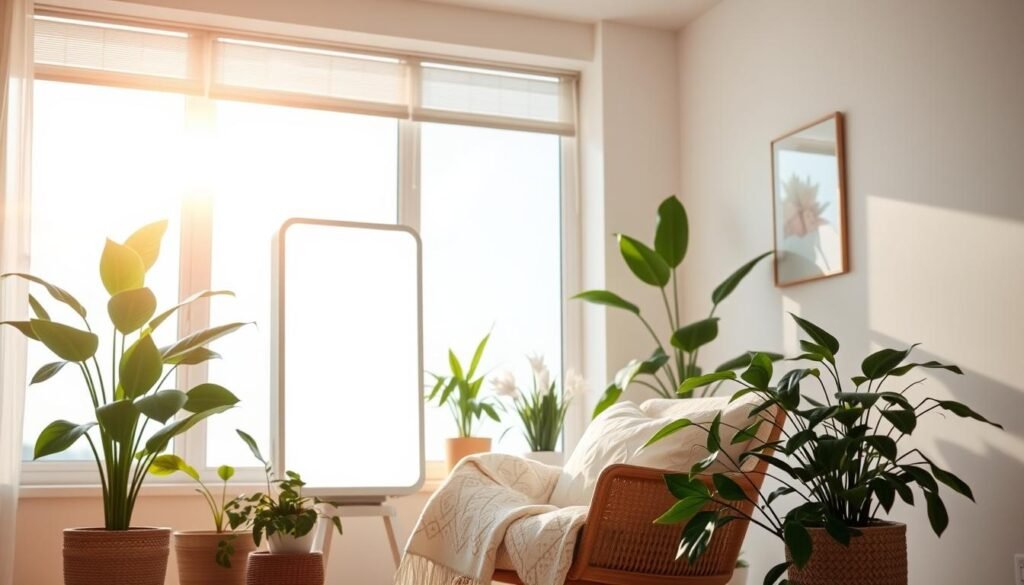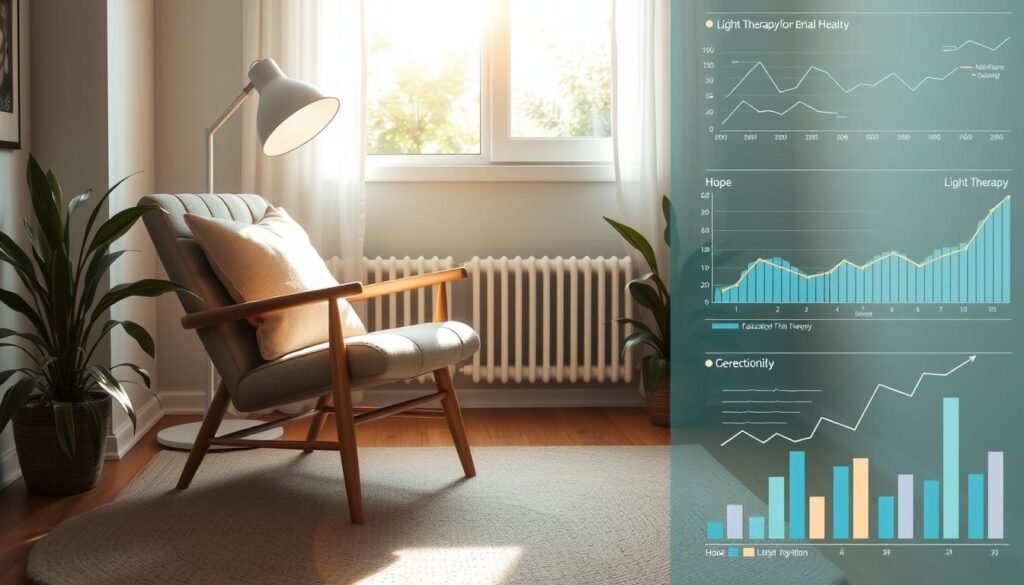Did you know about 20% of people with depression are affected by Seasonal Affective Disorder (SAD)? This condition often gets worse during fall and winter. Light therapy has become a helpful treatment for this kind of depression. It uses special light boxes to help ease depressive symptoms. This often comes with fewer side effects than traditional medications.
Studies show the mental health perks of light therapy. It boosts serotonin levels and helps regulate circadian rhythms. For many, this treatment without drugs is a way to find joy and balance again.
Key Takeaways
- Light therapy effectively treats Seasonal Affective Disorder.
- Exposure to 10,000 lux light is recommended to achieve optimal results.
- Using a light box for 20 to 30 minutes each morning can significantly improve mood.
- Many health insurance plans do not cover the cost of light therapy boxes.
- Consulting with a healthcare provider is crucial for choosing the right treatment.
- Common side effects include headaches and eyestrain, but they tend to be less severe than traditional medications.
- Light therapy may also assist with other mood-related and health conditions beyond depression.
Understanding Light Therapy and Its Importance
Light therapy is a non-invasive way to help with mental health. It uses artificial light to act like sunlight. This helps control your mood and body’s internal clock, or circadian rhythm.
By doing this, it can make you feel better emotionally and improve your life quality.
People with Seasonal Affective Disorder (SAD) or some types of Major Depressive Disorder (MDD) benefit from it. A study in 2024 found that it worked well for teens with depression. It made them feel happier and sleep better. Plus, they were likely to stick with this treatment.
Talking to a healthcare provider before starting light therapy is important. They can tailor it to fit your mental health needs and lifestyle. This ensures you get the most from light therapy. It becomes a key part of treating mental health.
How Light Therapy Works for Depression
Light therapy is key in fighting depression symptoms. By shining bright light on a person, it boosts serotonin in the brain. This serotonin lift helps manage mood, aiding those with mood disorders.
The therapy also fixes the body’s internal clock, or circadian rhythm. Bright light makes the brain’s chemical paths work better, setting a stable daily cycle. This helps create a regular sleep-wake pattern, vital for emotional health.
Studies show light therapy can quickly lift mood, especially in the darker months. It’s as effective as some medications, with fast results, sometimes in a week.

| Aspect | Bright Light Therapy | Psychotropic Medications |
|---|---|---|
| Effect Size for Seasonal Affective Disorder | 0.84 | N/A |
| Effect Size for Non-Seasonal Depression | 0.53 | N/A |
| Response Time | Within 1 week | Varies, often longer |
| Systemic Side Effects | Few | Potentially several |
| Dependency Risks | No | Possible |
Understanding these mechanisms shows the value of light therapy in treating depression. It improves our mental health by boosting serotonin and fixing our body clock.
Benefits of Light Therapy for Depression
Light therapy helps with depression, especially Seasonal Affective Disorder (SAD). It boosts mood and sleep. This has a big positive effect on mental health.
Enhancement of Serotonin Production
Light therapy raises serotonin, key for mood regulation. Bright light boosts serotonin in the brain. This makes you feel better and reduces depression signs. It lifts mood naturally, avoiding side effects from drugs.
Circadian Rhythm Regulation
It stabilizes your body’s internal clock. This clock can get off track due to seasonal changes or depression. Morning light exposure boosts your energy and keeps your mood stable all day. It helps you handle mood swings that come with depression.
Improvement in Sleep Quality
Light therapy makes sleep better. People find they fall asleep quicker and sleep more soundly. Good sleep is key for mental health and fighting depression. It also boosts serotonin and helps keep your internal clock steady. This creates a healthy cycle for mental health.

Light therapy brings benefits like serotonin boost, stable circadian rhythms, and better sleep. It’s a great treatment for depression symptoms. Knowing these benefits helps people make smart mental health choices.
| Benefit | Impact on Mental Health |
|---|---|
| Serotonin Enhancement | Improves mood and reduces depressive symptoms |
| Circadian Rhythm Stabilization | Promotes consistent energy levels and mood stability |
| Sleep Quality Improvement | Aids in faster sleep onset and deeper rest |
Light Therapy Effectiveness: What the Research Shows
Light therapy research shines a light, especially for those with Seasonal Affective Disorder (SAD) and Major Depressive Disorder (MDD). Studies indicate a quick drop in depressive symptoms for many, starting treatment. Bright light therapy (BLT) is proving effective, enhancing mood, bettering sleep, and keeping adolescent outpatients committed to treatment.
Light therapy does more than just uplift spirits. A 2023 meta-analysis of 13 studies found it boosts brain functions in dementia patients. It sharpens attention, executive function, and memory. Plus, it elevates energy and alertness by boosting serotonin, enhancing productivity and focus.
Light therapy also holds promise in reducing anxiety before surgery by upping melatonin levels. It even shows potential in treating eating disorders, helping with digestion and controlling appetite.

With few side effects like eyestrain or headache, light therapy is a top alternative to drugs. About 80% of SAD patients see a big improvement. Ongoing research on light therapy could reveal more about its broader uses and how it can complement other treatments. Light therapy is becoming a key player in combatting depression effectively.
For deeper insights into light therapy, feel free to check out this resource.
Bright Light Exposure and Seasonal Affective Disorder Treatment
Seasonal Affective Disorder (SAD) shows up as depression that comes back every year. It usually happens in the fall and winter when there isn’t much sunlight. People with SAD might feel very tired, have trouble sleeping, and feel hopeless. Light therapy, which involves being around very bright light, is the main way to treat SAD. It helps reduce these symptoms.
Seasonal Affective Disorder Explained
About 5% of the U.S. faces SAD. It makes people sleep too much, gain weight, and crave carbs. Since the 1980s, bright light therapy (BLT) has been a top treatment. Studies show it works for 61% of people using BLT, while only 32% see results with a placebo. Using lights that shine at 10,000 lux for 30 minutes in the morning is best. For more details on treatments, see recommended guidelines.
Combining Light Therapy with Other Treatments
Seasonal Affective Disorder treatment gets better when combining light therapy with other methods. Adding psychotherapy and antidepressants can make a big difference. This way, treatment is adjusted for each person, making it more effective. It’s a good idea to talk with a professional to get the best plan made for you.
| Treatment Method | Effectiveness | Recommended Use |
|---|---|---|
| Bright Light Therapy | High (61% remission rate) | 30 minutes at 10,000 lux |
| Psychotherapy | Moderate to High | As part of a comprehensive plan |
| Antidepressant Medications | Moderate | As needed alongside light therapy |
Using Light Therapy Safely and Effectively
Light therapy is great for treating depression, especially Seasonal Affective Disorder (SAD). It’s important to know the options and follow the right steps. This ensures a good experience.
Choosing the Right Light Box
When picking a light box for SAD, make sure it’s made for this use. A proper light box shines 10,000 lux of light, filtering out bad UV rays. This is way brighter than normal indoor lights. Talk to a healthcare provider to choose a light box that suits you, for safe and effective treatment.
Recommended Usage Guidelines
To get the most out of light therapy, follow the guidance on how to use it. Try using the light box every morning for 20 to 30 minutes, soon after you wake up. This routine is like getting natural sunlight which boosts serotonin and helps your body clock. Sit about 16 to 24 inches from the light for the best effect without hurting your eyes. Always follow the instructions from the manufacturer to avoid problems and have a good experience with the therapy.
Potential Side Effects of Light Therapy
Light therapy helps with mood disorders like depression. It’s usually safe, but it’s good to know about possible side effects. This way, people can use light therapy both effectively and safely.
Common Side Effects to Be Aware Of
Some mild side effects might happen with light therapy. They include:
- Irritability
- Headaches
- Eye strain
- Sleep disturbances
- Insomnia
If you feel any of these, try changing how long and how bright your light therapy is. Starting slowly and gradually increasing time can help. This approach reduces side effects while improving benefits.
Who Should Avoid Light Therapy
Some people should be cautious with light therapy. Consult a doctor if you have:
- Diseases affecting the retina, like macular degeneration
- Use of photosensitizing medications
- History of skin cancer
- Systemic lupus erythematosus
People over 65 and those with negative reactions should talk to an eye doctor. Getting advice guarantees light therapy is safe and effective for you. For more on light therapy side effects, read this page.
Non-Pharmaceutical Depression Management Options
Exploring alternative depression treatments offers new ways to handle depression without standard drugs. Psychotherapy is one of these methods. It helps people deal with symptoms and manage stress better.
Lifestyle changes are key for mental health. Getting regular exercise and good sleep can cut stress and anxiety. This approach shows that a whole-body strategy is vital for fighting depression.
Yoga and meditation are now seen as helpful add-ons for treating depression. They build emotional strength and give tools for handling symptoms. Treatments like acupuncture also support those with depression, showing the value of a full care plan.
Having active social ties is crucial for emotional well-being. Spending time with loved ones can offer deep support. It helps those with depression cope better. With these non-pharmaceutical options, people can tailor their mental health care to fit their needs and improve their life.
| Management Option | Description | Benefits |
|---|---|---|
| Psychotherapy | A therapeutic approach for coping with depression. | Improved stress management, coping skills. |
| Physical Activity | Regular exercise enhances mood and reduces anxiety. | Increased energy, better sleep quality. |
| Mindfulness Practices | Includes yoga and meditation for mental clarity. | Greater emotional resilience, stress reduction. |
| Social Interaction | Engaging with friends and family for support. | Enhanced coping mechanisms, emotional support. |
| Complementary Therapies | Includes acupuncture and alternative remedies. | Potential emotional relief, overall wellness. |
Looking into different non-pharmaceutical options for mental health is useful. It allows for a custom plan that can make life better.
For more on how depression affects one’s mind and body, check out this informative article.
Conclusion
Light therapy offers great help for those with depression, especially with Seasonal Affective Disorder (SAD). It boosts serotonin and fixes our sleep cycle. This makes us feel better and sleep well. Many studies show people using light therapy feel less depressed. It works as well as common antidepressant meds.
Light therapy is becoming key in managing mental health. It can quickly make moods better, which is crucial. For the best results, it’s smart to use light therapy with a doctor’s help. This ensures a comprehensive approach to improving life.
Exploring light therapy shows how it can change depression care. It helps people function better every day. Plus, it boosts overall mental health.